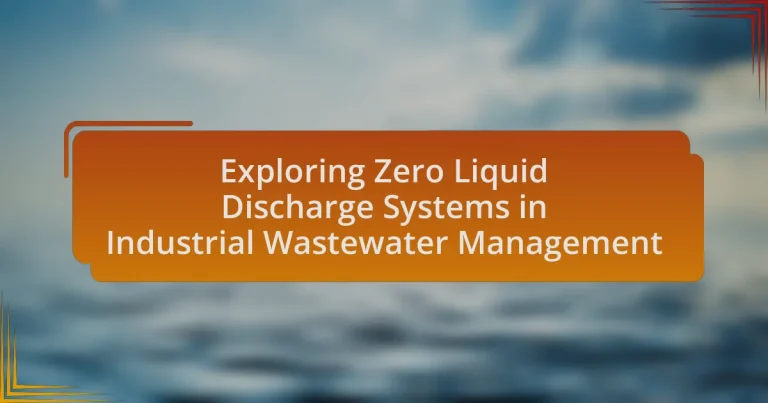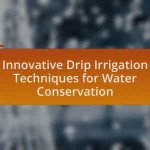Zero Liquid Discharge (ZLD) Systems are advanced wastewater management technologies aimed at minimizing liquid waste by recovering and reusing water in industrial processes. This article explores the functioning of ZLD systems, highlighting key technologies such as evaporation, crystallization, and membrane filtration that enable nearly complete water recovery. It discusses the importance of ZLD systems for industries facing stringent environmental regulations, their role in promoting sustainability, and the financial benefits associated with their implementation. Additionally, the article addresses potential challenges and best practices for successful adoption across various sectors, including power generation, textiles, pharmaceuticals, and food and beverage industries.
What are Zero Liquid Discharge Systems in Industrial Wastewater Management?
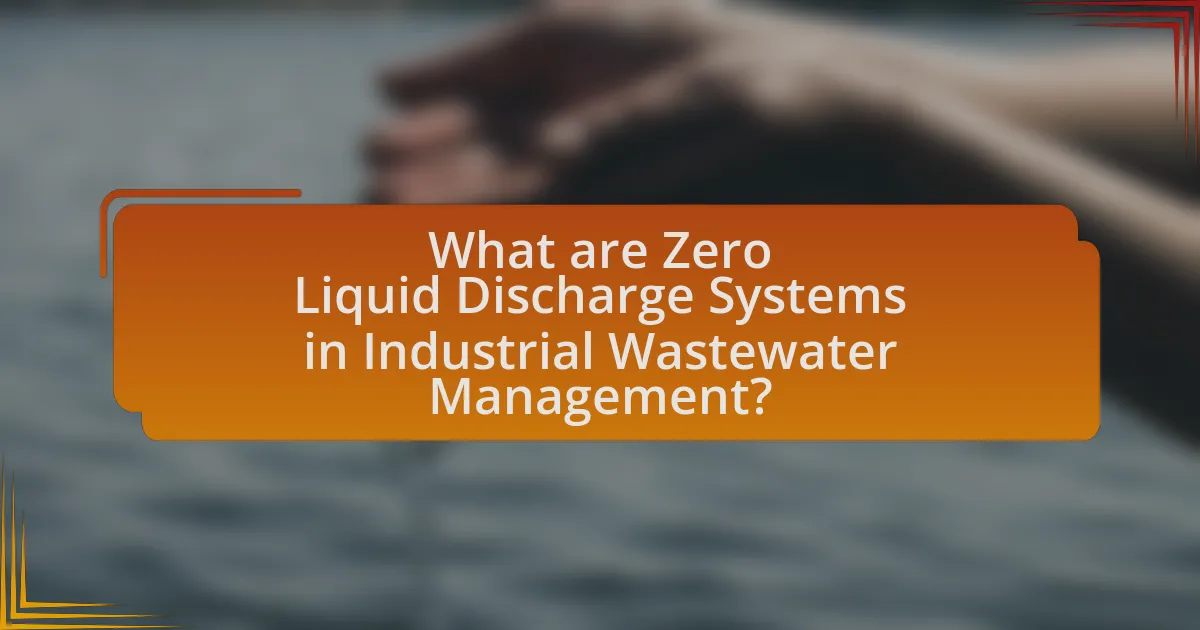
Zero Liquid Discharge (ZLD) Systems in industrial wastewater management are advanced treatment processes designed to minimize wastewater discharge by recovering and reusing water, thereby achieving zero liquid waste. These systems utilize a combination of technologies such as evaporation, crystallization, and membrane filtration to treat wastewater, ensuring that all liquid is either reused in the process or converted into solid waste for disposal. ZLD systems are increasingly adopted in industries like power generation, textiles, and pharmaceuticals, where regulatory pressures and sustainability goals drive the need for efficient water management.
How do Zero Liquid Discharge Systems function?
Zero Liquid Discharge (ZLD) Systems function by treating wastewater to recover water and minimize liquid waste. These systems employ a combination of processes such as evaporation, crystallization, and filtration to separate water from dissolved solids. The treated water can then be reused, while the remaining solids are disposed of or repurposed. ZLD systems are designed to achieve nearly complete water recovery, often exceeding 90%, thereby significantly reducing environmental impact and conserving water resources.
What are the key technologies used in Zero Liquid Discharge Systems?
The key technologies used in Zero Liquid Discharge (ZLD) Systems include reverse osmosis, evaporation, crystallization, and membrane distillation. Reverse osmosis is employed to separate dissolved solids from water, effectively reducing the volume of wastewater. Evaporation technology utilizes heat to convert liquid into vapor, leaving behind solid residues. Crystallization processes further extract salts and other solids from the concentrated brine, enabling their recovery and reuse. Membrane distillation leverages hydrophobic membranes to separate water vapor from contaminants, enhancing water recovery. These technologies collectively ensure that wastewater is treated to a point where no liquid waste is discharged, aligning with environmental regulations and sustainability goals.
How do these technologies contribute to wastewater treatment?
Zero Liquid Discharge (ZLD) technologies significantly enhance wastewater treatment by minimizing liquid waste and recovering valuable resources. These systems employ advanced processes such as evaporation, crystallization, and membrane filtration to treat industrial wastewater, ensuring that nearly all water is reused and contaminants are effectively removed. For instance, ZLD can achieve over 90% recovery of water from wastewater, which not only conserves water resources but also reduces the environmental impact of wastewater disposal. Additionally, ZLD technologies can recover salts and other byproducts, turning waste into reusable materials, thus promoting sustainability in industrial operations.
Why are Zero Liquid Discharge Systems important for industries?
Zero Liquid Discharge Systems are important for industries because they enable the complete recovery and reuse of water from wastewater, minimizing environmental impact. These systems help industries comply with stringent regulations regarding wastewater disposal, reduce water consumption, and lower operational costs associated with water sourcing and treatment. For instance, industries such as textiles and pharmaceuticals have adopted Zero Liquid Discharge practices to mitigate pollution and enhance sustainability, leading to significant reductions in freshwater usage and waste generation.
What environmental regulations drive the adoption of Zero Liquid Discharge Systems?
Environmental regulations such as the Clean Water Act in the United States and the European Union’s Water Framework Directive drive the adoption of Zero Liquid Discharge (ZLD) Systems. These regulations impose strict limits on the discharge of pollutants into water bodies, necessitating advanced treatment technologies like ZLD to minimize wastewater and recover valuable resources. For instance, the Clean Water Act mandates that industries must obtain permits that restrict the amount of contaminants released, which encourages the implementation of ZLD systems to achieve compliance and avoid penalties.
How do Zero Liquid Discharge Systems impact sustainability efforts?
Zero Liquid Discharge (ZLD) Systems significantly enhance sustainability efforts by minimizing wastewater generation and promoting resource recovery. These systems treat industrial wastewater to a level where nearly all water is recovered and reused, thereby reducing the environmental impact associated with wastewater disposal. For instance, ZLD systems can achieve over 90% water recovery, which conserves freshwater resources and decreases the need for water extraction from natural sources. Additionally, ZLD processes often involve the recovery of valuable byproducts, such as salts and minerals, which can be repurposed in various industries, further contributing to a circular economy.
What are the benefits of implementing Zero Liquid Discharge Systems?
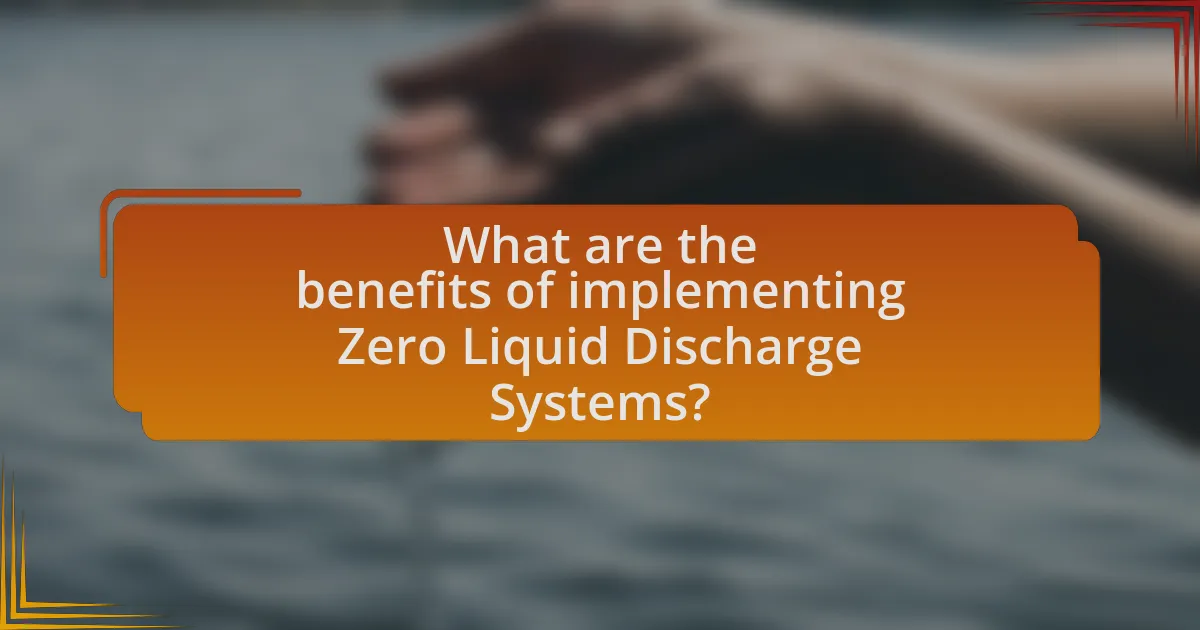
Implementing Zero Liquid Discharge (ZLD) Systems offers significant benefits, including the complete elimination of liquid waste, which minimizes environmental impact. ZLD systems enable industries to recycle and reuse water, thereby conserving freshwater resources and reducing operational costs associated with water procurement and wastewater treatment. Additionally, ZLD systems can enhance regulatory compliance by meeting stringent discharge standards, thus avoiding potential fines and improving corporate sustainability profiles. According to a study by the International Water Association, industries adopting ZLD technologies have reported up to 90% reduction in wastewater disposal costs, demonstrating the economic viability of such systems.
How do Zero Liquid Discharge Systems reduce operational costs?
Zero Liquid Discharge Systems reduce operational costs by minimizing wastewater disposal expenses and maximizing resource recovery. These systems eliminate the need for costly wastewater treatment and disposal methods, such as landfilling or incineration, which can incur significant fees. Additionally, by recovering valuable resources like water and salts from the wastewater, industries can reduce their reliance on external water sources and raw materials, leading to lower operational costs. For instance, a study by the National Renewable Energy Laboratory found that implementing Zero Liquid Discharge can save industries up to 30% in water costs, demonstrating the financial benefits of these systems in industrial wastewater management.
What are the long-term financial benefits of Zero Liquid Discharge Systems?
Zero Liquid Discharge (ZLD) Systems provide significant long-term financial benefits by reducing wastewater disposal costs and enabling resource recovery. These systems minimize the volume of wastewater generated, which lowers treatment and disposal expenses, often leading to savings of up to 30-50% compared to conventional methods. Additionally, ZLD allows for the recovery of valuable by-products, such as salts and water, which can be reused in industrial processes, further decreasing operational costs. Implementing ZLD can also enhance regulatory compliance, reducing the risk of fines and penalties associated with wastewater discharge violations. Overall, the adoption of ZLD Systems can lead to substantial cost savings and improved financial performance over time.
How do these systems minimize waste disposal fees?
Zero Liquid Discharge (ZLD) systems minimize waste disposal fees by significantly reducing the volume of wastewater that requires treatment and disposal. These systems achieve this by recovering and reusing water from industrial processes, thereby decreasing the amount of liquid waste generated. For instance, ZLD technologies can recover up to 90% of water from wastewater, which not only lowers disposal costs but also reduces the need for fresh water intake. Additionally, by concentrating waste into solid residues, ZLD systems facilitate easier and cheaper disposal methods, such as landfilling or incineration, compared to liquid waste disposal. This efficiency in water recovery and waste minimization directly correlates with reduced operational costs associated with waste management.
What are the potential challenges of Zero Liquid Discharge Systems?
The potential challenges of Zero Liquid Discharge (ZLD) Systems include high capital and operational costs, technical complexity, and energy consumption. High capital costs arise from the need for advanced technologies and equipment, such as membrane filtration and evaporation systems, which can significantly increase initial investment. Operational costs are also elevated due to the energy-intensive processes involved in treating wastewater to achieve zero discharge. Additionally, the technical complexity of ZLD systems can lead to difficulties in maintenance and operation, requiring specialized skills and knowledge. Energy consumption is a critical concern, as ZLD processes often demand substantial energy inputs, which can impact the overall sustainability and economic viability of the system.
What technical difficulties might industries face during implementation?
Industries may face several technical difficulties during the implementation of Zero Liquid Discharge (ZLD) systems, including high capital costs, complex system integration, and operational challenges. High capital costs arise from the need for advanced technologies and equipment, which can deter investment; for instance, ZLD systems often require specialized membranes and evaporators that significantly increase initial expenditures. Complex system integration poses challenges as existing infrastructure may not easily accommodate new ZLD technologies, necessitating extensive modifications or replacements. Operational challenges include maintaining system efficiency and managing the quality of the wastewater, as fluctuations in feedwater characteristics can impact performance and increase maintenance requirements. These difficulties highlight the need for careful planning and investment in training and technology to ensure successful implementation of ZLD systems.
How can industries overcome these challenges?
Industries can overcome challenges in implementing Zero Liquid Discharge (ZLD) systems by investing in advanced technologies and optimizing operational processes. For instance, utilizing membrane filtration and evaporation technologies can significantly enhance water recovery rates, reducing the volume of wastewater generated. A study by the International Water Association highlights that ZLD systems can achieve over 90% water recovery, demonstrating their effectiveness in minimizing waste. Additionally, industries can collaborate with technology providers to tailor solutions that meet specific operational needs, ensuring efficient integration of ZLD systems into existing processes.
How do different industries utilize Zero Liquid Discharge Systems?
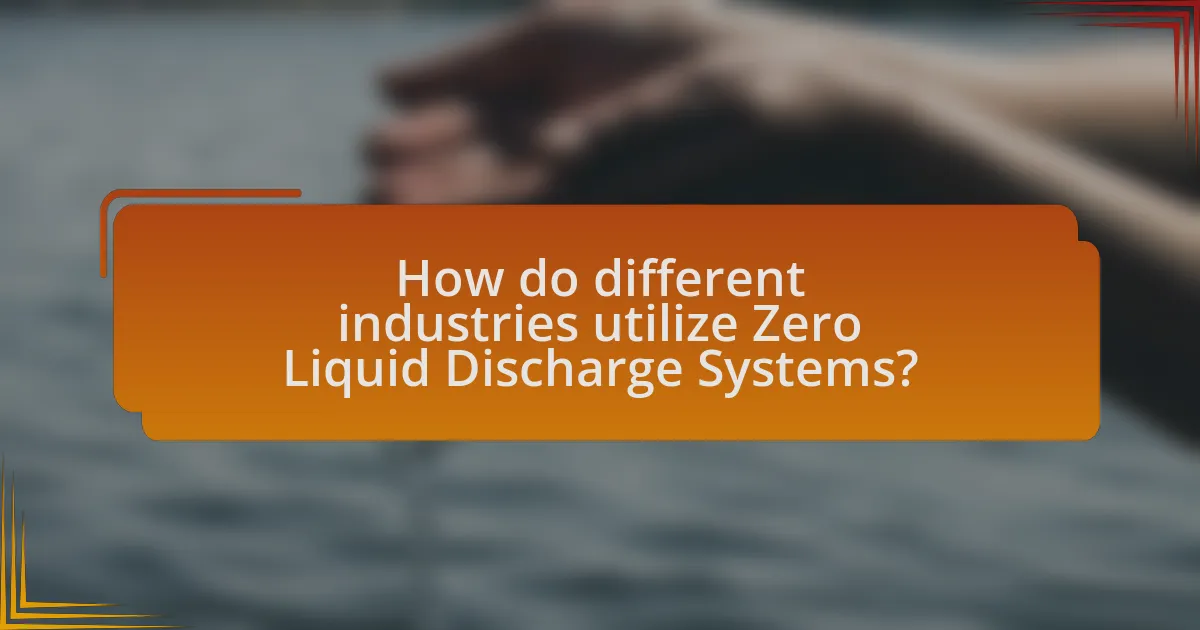
Different industries utilize Zero Liquid Discharge (ZLD) Systems to minimize wastewater and recover valuable resources. In the power generation sector, ZLD systems are employed to treat cooling tower blowdown and boiler blowdown, allowing for the reuse of water and the recovery of salts, which can be repurposed in other processes. The textile industry uses ZLD to manage dyeing and finishing wastewater, ensuring that harmful chemicals are not released into the environment while recovering water for reuse in production. In the food and beverage sector, ZLD systems treat wastewater from processing operations, enabling the recovery of clean water and reducing the environmental impact of effluent discharge. Additionally, the pharmaceutical industry implements ZLD to handle complex wastewater streams, ensuring compliance with stringent regulations while recovering solvents and other valuable materials. These applications demonstrate the effectiveness of ZLD systems in promoting sustainability and resource efficiency across various industrial sectors.
Which industries are leading in the adoption of Zero Liquid Discharge Systems?
The industries leading in the adoption of Zero Liquid Discharge (ZLD) Systems are primarily the power generation, textile, pharmaceuticals, and food and beverage sectors. These industries are driven by stringent environmental regulations and the need for sustainable water management practices. For instance, the power generation sector often utilizes ZLD to minimize wastewater discharge and recover valuable resources, while the textile industry adopts ZLD to address the high water consumption and pollution associated with dyeing processes.
What specific applications exist for Zero Liquid Discharge Systems in the chemical industry?
Zero Liquid Discharge (ZLD) Systems are specifically applied in the chemical industry for wastewater treatment, resource recovery, and environmental compliance. These systems enable the complete elimination of liquid waste by treating and recycling wastewater, thus allowing for the recovery of valuable by-products such as salts and chemicals. For instance, ZLD is utilized in the production of specialty chemicals, where it helps in managing brine and other effluents, ensuring that no liquid waste is discharged into the environment. Additionally, ZLD systems are essential in industries like petrochemicals and pharmaceuticals, where stringent regulations mandate the reduction of liquid waste to minimize environmental impact.
How are Zero Liquid Discharge Systems applied in the food and beverage sector?
Zero Liquid Discharge Systems are applied in the food and beverage sector to minimize wastewater generation and recover valuable resources. These systems utilize advanced technologies such as membrane filtration, evaporation, and crystallization to treat wastewater, ensuring that nearly all liquid is recovered and reused in the production process. For instance, a study by the Water Environment Federation highlights that implementing Zero Liquid Discharge can lead to a reduction of up to 90% in wastewater discharge, significantly lowering environmental impact and operational costs.
What are the best practices for implementing Zero Liquid Discharge Systems?
The best practices for implementing Zero Liquid Discharge (ZLD) Systems include conducting a comprehensive feasibility study, selecting appropriate technologies, optimizing system design, and ensuring regulatory compliance. A feasibility study assesses the economic and technical viability of ZLD, which is crucial for successful implementation. Selecting technologies such as reverse osmosis, evaporation, and crystallization is essential, as these processes effectively recover water and minimize waste. Optimizing system design involves integrating various treatment processes to enhance efficiency and reduce energy consumption. Additionally, ensuring compliance with environmental regulations is vital to avoid legal issues and promote sustainable practices. These practices are supported by industry case studies demonstrating successful ZLD implementations, such as those in the textile and pharmaceutical sectors, which have achieved significant water recovery and waste reduction.
How can industries assess their readiness for Zero Liquid Discharge Systems?
Industries can assess their readiness for Zero Liquid Discharge (ZLD) Systems by conducting a comprehensive evaluation of their current wastewater management practices, resource availability, and technological capabilities. This assessment typically involves analyzing existing wastewater streams, identifying the volume and composition of effluents, and determining the feasibility of implementing ZLD technologies based on economic and environmental factors.
For instance, a study by the International Water Association highlights that industries should perform a cost-benefit analysis to evaluate the financial implications of ZLD systems compared to traditional methods. Additionally, assessing regulatory compliance and sustainability goals can provide insights into the necessity and urgency of adopting ZLD practices.
What steps should be taken to ensure successful implementation?
To ensure successful implementation of Zero Liquid Discharge (ZLD) systems in industrial wastewater management, organizations should follow a structured approach that includes thorough planning, stakeholder engagement, technology selection, and continuous monitoring. First, conducting a comprehensive feasibility study is essential to assess the specific needs and constraints of the facility, which helps in identifying the most suitable ZLD technologies. Engaging stakeholders, including regulatory bodies and local communities, fosters collaboration and addresses potential concerns early in the process.
Next, selecting the appropriate technology, such as membrane distillation or crystallization, based on the characteristics of the wastewater and the desired outcomes is crucial for effective implementation. Additionally, establishing a detailed project timeline and budget ensures that resources are allocated efficiently. Finally, implementing a robust monitoring and maintenance plan is vital to ensure the system operates optimally and meets regulatory compliance over time. These steps collectively enhance the likelihood of successful ZLD system implementation, as evidenced by case studies showing improved environmental performance and cost savings in industries adopting these practices.
